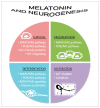Benefits of the Neurogenic Potential of Melatonin for Treating Neurological and Neuropsychiatric Disorders
- PMID: 36902233
- PMCID: PMC10002978
- DOI: 10.3390/ijms24054803
Benefits of the Neurogenic Potential of Melatonin for Treating Neurological and Neuropsychiatric Disorders
Abstract
There are several neurological diseases under which processes related to adult brain neurogenesis, such cell proliferation, neural differentiation and neuronal maturation, are affected. Melatonin can exert a relevant benefit for treating neurological disorders, given its well-known antioxidant and anti-inflammatory properties as well as its pro-survival effects. In addition, melatonin is able to modulate cell proliferation and neural differentiation processes in neural stem/progenitor cells while improving neuronal maturation of neural precursor cells and newly created postmitotic neurons. Thus, melatonin shows relevant pro-neurogenic properties that may have benefits for neurological conditions associated with impairments in adult brain neurogenesis. For instance, the anti-aging properties of melatonin seem to be linked to its neurogenic properties. Modulation of neurogenesis by melatonin is beneficial under conditions of stress, anxiety and depression as well as for the ischemic brain or after a brain stroke. Pro-neurogenic actions of melatonin may also be beneficial for treating dementias, after a traumatic brain injury, and under conditions of epilepsy, schizophrenia and amyotrophic lateral sclerosis. Melatonin may represent a pro-neurogenic treatment effective for retarding the progression of neuropathology associated with Down syndrome. Finally, more studies are necessary to elucidate the benefits of melatonin treatments under brain disorders related to impairments in glucose and insulin homeostasis.
Keywords: adult hippocampal neurogenesis; melatonin; neural stem cells; neurodegeneration; neurological disorders.
Conflict of interest statement
The authors declare no conflict of interest.
Figures



References
-
- Menendez-Pelaez A., Howes K.A., Gonzalez-Brito A., Reiter R.J. N-acetyltransferase activity, hydroxyindole-O-methyltransferase activity, and melatonin levels in the Harderian glands of the female Syrian hamster: Changes during the light:dark cycle and the effect of 6-parachlorophenylalanine administration. Biochem. Biophys. Res. Commun. 1987;145:1231–1238. doi: 10.1016/0006-291X(87)91569-5. - DOI - PubMed
-
- Tan D.X., Manchester L.C., Reiter R.J., Qi W.B., Zhang M., Weintraub S.T., Cabrera J., Sainz R.M., Mayo J.C. Identification of highly elevated levels of melatonin in bone marrow: Its origin and significance. Biochimica Biophysica Acta. 1999;1472:206–214. doi: 10.1016/S0304-4165(99)00125-7. - DOI - PubMed
Publication types
MeSH terms
Substances
Grants and funding
LinkOut - more resources
Full Text Sources

